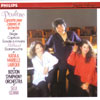French Works for Two Pianos
View record and artist detailsRecord and Artist Details
Composer or Director: Darius Milhaud, Francis Poulenc
Label: Classics
Magazine Review Date: 8/1991
Media Format: CD or Download
Media Runtime: 60
Mastering:
DDD
Catalogue Number: 426 284-2PH

Tracks:
| Composition | Artist Credit |
|---|---|
| Concerto for Two Pianos and Orchestra |
Francis Poulenc, Composer
Boston Symphony Orchestra Francis Poulenc, Composer Katia Labèque, Piano Marielle Labèque, Piano Seiji Ozawa, Conductor |
| Capriccio |
Francis Poulenc, Composer
Francis Poulenc, Composer Katia Labèque, Piano Marielle Labèque, Piano |
| (L') Embarquement pour Cythère |
Francis Poulenc, Composer
Francis Poulenc, Composer Katia Labèque, Piano Marielle Labèque, Piano |
| Sonata for Piano Duet |
Francis Poulenc, Composer
Francis Poulenc, Composer Katia Labèque, Piano Marielle Labèque, Piano |
| Elégie |
Francis Poulenc, Composer
Francis Poulenc, Composer Katia Labèque, Piano Marielle Labèque, Piano |
| Scaramouche |
Darius Milhaud, Composer
Darius Milhaud, Composer Katia Labèque, Piano Marielle Labèque, Piano |
Author: Christopher Headington
The Concerto for two pianos begins here with tremendous attack, reminding me more than usual of the Balinese gamelan which the composer heard in Paris in 1931 and which he said was echoed in this work, written soon after for himself and Jacques Fevrier. This is gong kebyar style, with its characteristic explosive attack at the start of a composition, although the exquisitely languorous music just near the end of the movement (5'27'') is equally Balinese, while quite different in mood. I'm surprised that the note does not mention the use of such an exotic idiom, which anticipates Britten's similar practice by 25 years.
The poised delicacy that the Labeques bring to the slow section mentioned above is very idiomatic, and Ozawa and his orchestra match them. It does much to make up for their playing of the main part of this movement, which I find to be too athletic, tonally and tempo-wise, to convey much wit or charm; after all, this is an allegro ma non troppo, and I prefer the excellent Collard and Duchable (Erato/Warner Classics), who bring more space and sense of fun to the music. The Labeques' performance of the Larghetto is more stylish, though it is overprojected in the climax near the four-minute mark, and the rumbustious finale goes with elan. The sound is well enough balanced, but reverberant and rather hard in big passages—as from 3'40'' and 5'08'' in the finale; the Erato sound is more pleasant.
The other pieces on this Philips disc go with aplomb, although one hears the odd extraneous noise, such as a loud indrawn breath at 3'47'' in the Capriccio. But, again, I find the playing of the Labeques more energetic than attractive. Too often in forte their tone is harsh and their rhythm unyielding; in gentler passages they are more flexible, but even here one waits anxiously for the next shock attack—as at 3'10'' in the Capriccio. I wish, too, that instead of Milhaud's Scaramouche (done with panache though it is) we had been given Poulenc's Sonata for two pianos, which although 15 minutes longer would have fitted on to the disc. Tanyel and Brown's CD (Chandos) is even shorter at 45 minutes, but includes all Poulenc's four-hand music with more attractive playing than the Labeques offer, and clear sound. But like LS in his review, I think their Modere immoderate in the first movement of the Duet Sonata.
'
The poised delicacy that the Labeques bring to the slow section mentioned above is very idiomatic, and Ozawa and his orchestra match them. It does much to make up for their playing of the main part of this movement, which I find to be too athletic, tonally and tempo-wise, to convey much wit or charm; after all, this is an allegro ma non troppo, and I prefer the excellent Collard and Duchable (Erato/Warner Classics), who bring more space and sense of fun to the music. The Labeques' performance of the Larghetto is more stylish, though it is overprojected in the climax near the four-minute mark, and the rumbustious finale goes with elan. The sound is well enough balanced, but reverberant and rather hard in big passages—as from 3'40'' and 5'08'' in the finale; the Erato sound is more pleasant.
The other pieces on this Philips disc go with aplomb, although one hears the odd extraneous noise, such as a loud indrawn breath at 3'47'' in the Capriccio. But, again, I find the playing of the Labeques more energetic than attractive. Too often in forte their tone is harsh and their rhythm unyielding; in gentler passages they are more flexible, but even here one waits anxiously for the next shock attack—as at 3'10'' in the Capriccio. I wish, too, that instead of Milhaud's Scaramouche (done with panache though it is) we had been given Poulenc's Sonata for two pianos, which although 15 minutes longer would have fitted on to the disc. Tanyel and Brown's CD (Chandos) is even shorter at 45 minutes, but includes all Poulenc's four-hand music with more attractive playing than the Labeques offer, and clear sound. But like LS in his review, I think their Modere immoderate in the first movement of the Duet Sonata.
'
Discover the world's largest classical music catalogue with Presto Music.

Gramophone Digital Club
- Digital Edition
- Digital Archive
- Reviews Database
- Full website access
From £8.75 / month
Subscribe
Gramophone Full Club
- Print Edition
- Digital Edition
- Digital Archive
- Reviews Database
- Full website access
From £11.00 / month
Subscribe
If you are a library, university or other organisation that would be interested in an institutional subscription to Gramophone please click here for further information.




